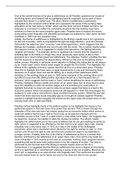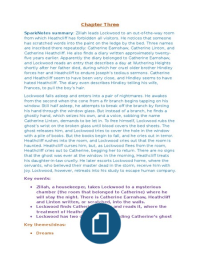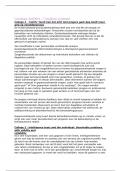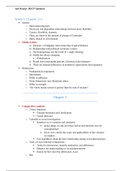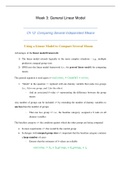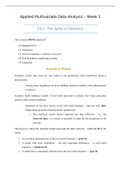Note: These are just questions I have made myself and are not in any way connected to the
official exam
Note: Answer key at the end of the document
1. Development can be defined as:
a) Increasing GDP and industrialization
b) Expanding people's freedoms and capabilities
c) Reducing poverty and inequality
d) Promoting sustainable practices
2. Amartya Sen argues that development should be evaluated in terms of:
a) Economic growth and market expansion
b) Material wealth and industrialization
c) Increasing people's freedoms and capabilities
d) Reducing social exclusion and inequality
3. According to Wolfgang Sachs, the concept of development is flawed because:
a) It focuses too much on economic growth
b) It ignores the historical context of colonialism
c) It perpetuates global inequalities
d) All of the above
4. "Green colonialism" refers to:
a) The use of renewable energy in wealthy countries
b) The imposition of climate policies on developing nations
c) The exploitation of natural resources in indigenous lands
d) The promotion of sustainable development practices
5. The Human Development Index measures development based on:
a) Economic growth and GDP per capita
b) Life expectancy, education, and standard of living
c) Environmental sustainability and resource consumption
d) Poverty rates and income inequality
6. The concept of "sustainable development" emphasizes:
a) Economic growth at any cost
b) Preservation of natural resources for future generations
c) Rapid industrialization and urbanization
d) Exploitation of local communities for global benefit
7. The term "North-South divide" refers to:
a) The cultural differences between northern and southern regions
b) The economic and social disparities between developed and developing countries
c) The geographical separation between countries in the northern and southern hemispheres
d) The political tensions between northern and southern nations
, 8. The United Nations' Millennium Development Goals (MDGs) were established
to:
a) Promote sustainable development practices in all countries
b) Eradicate poverty and improve global health by 2015
c) Increase military spending for global security
d) Address climate change and protect biodiversity
9. The concept of "decoloniality" in development studies aims to:
a) Undo the effects of colonialism and challenge Eurocentric perspectives
b) Promote further colonization and exploitation of resources
c) Support the dominance of Western powers in global development initiatives
d) Foster cultural assimilation and homogeneity
10. The "capabilities approach" to development, proposed by Amartya Sen and
Martha Nussbaum, emphasizes:
a) Economic growth and market competition
b) Individual freedoms and well-being
c) Technological advancements and industrialization
d) Centralized planning and government control
11. According to Ricardo Hausmann, geography can influence economic
development through factors such as climate, topography, natural resources,
and access to trade routes. Which of the following is NOT mentioned as a way
in which geography affects development?
a) Transportation and coordination costs limit trade and globalization
b) Climate limits agricultural and labor productivity
c) Cultural diversity affects social cohesion
d) Vulnerability to natural disasters damages infrastructure and causes conflict
12. The term "resource curse" refers to:
a) The abundance of natural resources leading to economic growth
b) The negative impact of geography on a country's development
c) The negative consequences of natural resource abundance on economic and political
development
d) The competition for control over natural resources leading to political instability
13. Which of the following is NOT mentioned as a potential economic effect of
natural resource abundance?
a) Commodity prices decline relative to manufactured goods over time
b) Commodity prices are volatile
c) Natural resources lead to spillovers in other sectors of the economy
d) Dutch Disease affects other exports due to exchange rate distortions
14. The resource curse can be mitigated and managed through careful government
action. Which of the following is NOT mentioned as a possible solution?
a) Stabilization funds to manage Dutch Disease
b) Diversification of the economy
c) Addressing gendered risks and inequality in mining areas
, d) Imposing higher taxes on natural resource extraction
15. Which of the following political effects is associated with the resource curse?
a) Increased democratic accountability
b) Strengthened social contract between citizens and the government
c) Authoritarianism and leaders staying in power for long periods
d) Enhanced institutions and high levels of taxation
16. According to the lecture notes, which country is mentioned as an example of
effectively managing natural resource wealth to avoid the resource curse?
a) Norway
b) Angola
c) Sierra Leone
d) Cuba
17. Under what conditions do natural resources harm development, according to
the lecture notes?
a) When they generate large, state-controlled rents
b) When resources are controlled by multinational corporations
c) When institutions are strong and well-established
d) When there is high political transparency and accountability
18. What is one recommendation mentioned in the lecture notes for Uganda to
maximize the impact of its new oil discoveries on development?
a) Nationalize the oil industry to ensure government control
b) Spend the oil revenues immediately on infrastructure projects
c) Implement effective development funds to save and protect the money
d) Exclude the local population from decision-making on oil revenue allocation
19. The lecture notes highlight that geography alone cannot fully explain
development disparities. Which of the following is mentioned as an example of
countries with different development outcomes despite similar geography?
a) Singapore and Shenzhen/Guangzhou
b) Costa Rica and Switzerland
c) Botswana and Norway
d) Central America and Latin America
20. The lecture notes mention that the resource curse is not inevitable and provide
examples of countries that have managed to avoid its negative consequences.
Which of the following is NOT mentioned as a factor contributing to their
success?
a) Strong democratic institutions
b) Effective management of resource rents
c) Prevalence of nationalized firms
d) Prioritizing long-term development goals
21. According to the lecture notes, what is the definition of an institution?
a) A government organization

